When it comes to smoking a pork butt, there is a lot of debate surrounding when to wrap it. Some pitmasters swear by wrapping the meat in foil after a few hours to speed up cooking and prevent it from drying out, while others prefer to let it cook uncovered the entire time for a crispy bark. So, when should you wrap your pork butt? As with many things in barbecue, the answer is that it depends. Factors such as the size of the cut, the temperature of your smoker, and your desired texture will all influence when and if you choose to wrap. In this article, we’ll explore the pros and cons of pork butt wrapping and share some tips on when to wrap pork butt for the best results.
What is Pork Butt?
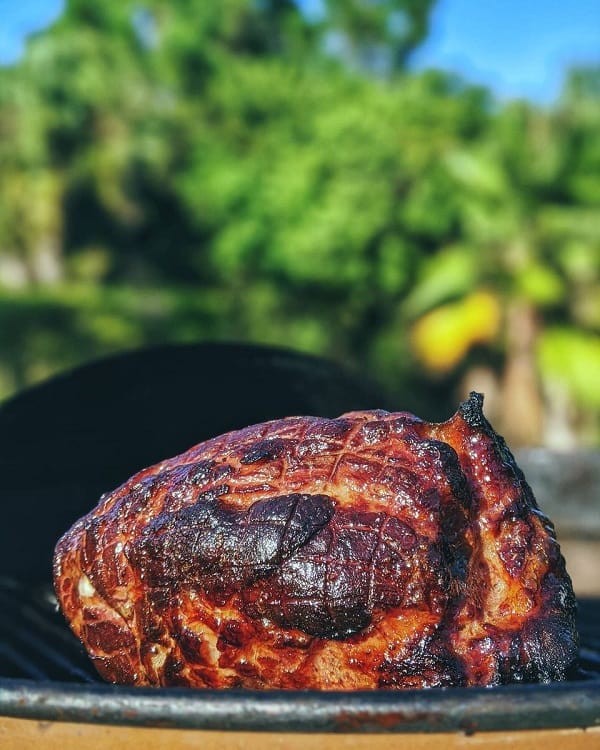
A pork butt is a cut of pork that comes from the shoulder area of the pig, just below the neck. It is made up of two different muscles – the shoulder blade, also known as the Boston butt, and the upper part of the shoulder, known as the picnic shoulder.
Because the shoulder area of the pig is full of fat and connective tissue, pork butt is a great choice for slow-cooking methods like braising and BBQing. The fat and connective tissue help to keep the meat tender and juicy, and when cooked slowly, the fat melts away and adds a rich flavor.
For BBQing, pork butt is often rubbed with spices and cooked slowly over indirect heat until the meat is a deep, golden brown. It can also be cooked as a whole roast, served in sandwiches, or chopped up for tacos.
Why Do You Wrap Pork Butt?
Are you wondering why you should wrap pork butt when cooking it? Wrapping pork butt can be a great way to ensure a succulent, flavorful meal. There are several reasons why you should wrap pork butt when cooking, including sealing in moisture, stronger flavor, and speeding up the cooking process.
Seals in Moisture
First and foremost, wrapping pork butt helps to seal in moisture. By wrapping pork butt, you are creating a barrier between the meat and the heat of the cooking environment. This barrier helps to keep the steam and moisture generated by the pork as it cooks from evaporating and drying out the meat. Wrapping pork butt also helps retain the meat’s juices and flavor, which can be lost if cooked without being wrapped.
Stronger Flavor
Second, wrapping pork butt helps to create a stronger flavor. By wrapping the pork in foil, you are trapping the flavor of the seasonings and herbs you use with the pork. This means that the flavor of the seasonings and herbs will be released gradually as the pork cooks, giving you a more intense and complex flavor.
Speeds Up The Cooking Process
Finally, wrapping pork butt can help to speed up the cooking process. Creating a barrier between the heat of the oven and the pork makes the heat more evenly distributed, resulting in a quicker cooking time. This can be especially helpful if you are pressed for time, as you can have a succulent, flavorful pork roast ready in a fraction of the time.
When To Wrap Pork Butt?
When cooking pork butt, wrapping is a great technique to ensure the meat is tender and juicy. The ideal time to wrap the pork butt is when its internal temperature is between 150 and 170°F and the outer crust is to the cook’s liking. Covering the pork butt at this point helps to avoid the stall and keep the meat moist.
Some factors, like the size of the meat, cooking method, and desired results, can impact when to wrap. Nonetheless, a general rule of thumb is to wrap pork butt when it reaches an internal temperature of 165°F. Wrapping in foil or butcher paper works well at different stages of cooking, depending on the desired result.
What Are The Signs That A Pork Butt Is Ready To Be Wrapped?
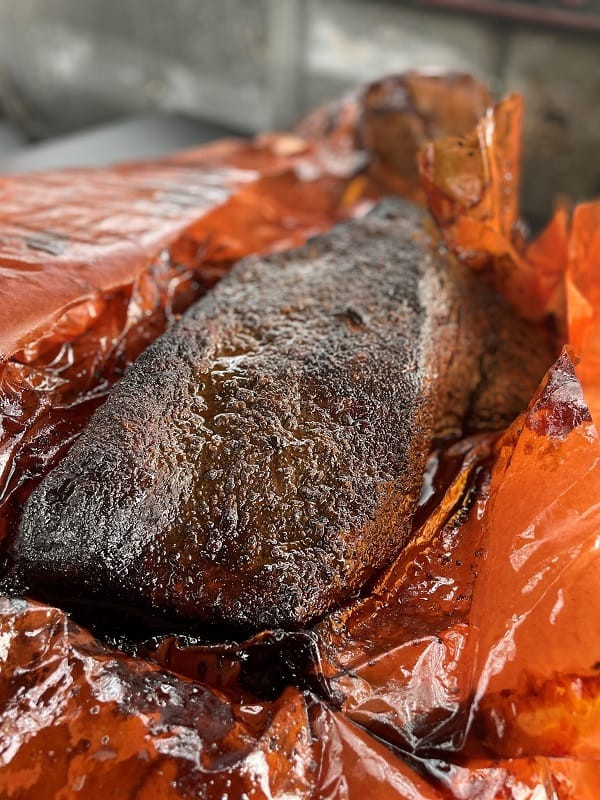
When it comes to smoking a pork butt, timing is everything, and there are a few tell-tale signs that the meat is ready to be wrapped.
- Firstly, the outer crust, or “bark,” should be dark and firm, with a slight crackling texture. This usually occurs after around 5 hours of smoking.
- Secondly, the internal temperature of the pork should be between 150 and 170°F. At this point, the meat will have absorbed a good amount of smoky flavor, and wrapping it will help to lock in moisture and enhance the tenderness.
- Finally, some experts recommend wrapping the pork when it reaches an internal temperature of 165°F to be on the safe side.
Does The Wrapping Process Affect The Flavor Of The Pork Butt?
When wrapped at the right time, the foil can trap the fat, juices, and smoke flavor from the dry rub and apple cider vinegar to retain the pork’s delicious juiciness. Wrapping also reduces cooking time and can lead to better results. However, if not done properly or for too long, the bark and texture may suffer, and the meat can taste like pot roast.
Should I Wrap Pork Butt in Foil or Butcher Paper?
Wrapping pork butt in foil is the tried and true method of many experienced pitmasters. Foil is an excellent choice for creating a juicy and tender end product since it helps to lock in moisture and helps to keep the pork butt from drying out. However, it’s important to note that some of the smoky flavors you get from cooking with a smoker will be lost when using foil.
On the other hand, there are some great reasons to wrap pork butt in butcher paper instead. Butcher paper is a large waxed paper that helps retain moisture and a smoky flavor. It also allows the fat and juices from the pork to drip through, giving you a more flavorful end product. The downside is that it can be more difficult to achieve a crispy exterior when using butcher paper.
If you’re looking for a juicy and tender pork butt with a smoky flavor, then foil is the way to go. However, if you’re looking for a more flavorful end product with a crispy exterior, butcher paper is the way to go. While both options have pros and cons, the choice ultimately depends on the flavor you want to create.
What Temp to Wrap Pork Butt?
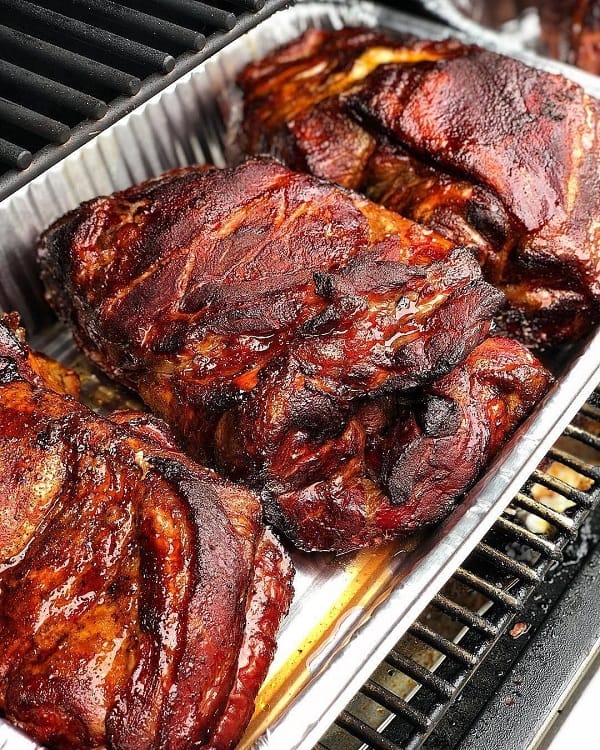
According to factual data, the ideal temperature to wrap the pork butt is when it reaches an internal temperature of 150 to 170°F. This is typically achieved after a few hours of cooking. Wrapping the pork butt at this temperature will help retain moisture and facilitate cooking. Pitmasters often wrap their pork butts to ensure a tender and juicy final product. It’s important to remember that the bark of the pork butt should be firm and beginning to crack before wrapping it to prevent it from becoming soft.
Read more:
How To Wrap Your Pork Butt In Butcher Paper
Here’s how to wrap your pork butt in butcher paper:
- Start by laying a large heavy-duty butcher paper on a counter or table. Place the pork butt in the center of the paper, fat side down.
- Fold the sides of the paper up and around the pork butt, ensuring that all sides are securely wrapped and sealed.
- When the sides are securely wrapped and sealed, turn the pork butt over and repeat the process on the other side.
- Make sure that all sides are tightly sealed around the pork butt.
- Finally, tie the ends of the butcher paper together with the butcher’s twine or kitchen string so that the pork butt is securely wrapped.
Once your pork butt is securely wrapped in butcher paper, you’ll be ready to begin the cooking process. You can use butcher paper to wrap the pork butt however you see fit, whether on the grill, in the oven, or a smoker. The butcher paper will ensure that your pork butt stays juicy and flavorful throughout the cooking process.
How To Wrap Your Pork Butt In Foil
Here are some tips to help you get the best results:
- Start by rubbing your pork butt with your favorite seasoning or rub. This will add a great flavor to your finished product.
- Place your pork butt in a large sheet of heavy-duty aluminum foil. Make sure it is large enough to wrap around the butt completely.
- Now carefully fold the aluminum foil around the pork butt. Make sure you wrap it tightly, but not so tight that you crush the meat.
- Place the pork butt in the smoker, on the grill, or in the oven. The foil will help to keep the moisture in and the smoke out.
- Cook the pork butt until it reaches the desired internal temperature. This is usually around 195-205°F.
- Once the pork butt has reached the desired temperature, remove it from the heat and let it rest for 10-15 minutes.
- Carefully unwrap the pork butt from the foil and enjoy!
How to Smoke Pork Butt
Smoking pork butt requires patience and a few key steps. If done correctly, you can create a juicy and flavorful pork butt that your family and friends will love.
- Let’s start by trimming away any excess fat from the pork butt. This will help the rub penetrate the meat and give it a better flavor. Once the fat has been trimmed off, liberally season the butt with a Pork Rub. This will create a nice flavor and make sure the meat stays moist.
- Next, you’ll need to choose your wood pellets. Hickory and apple are two great choices, but you can also use a blend of pellets to create a more complex flavor.
- Once you have your wood pellets chosen, it’s time to set your grill to 225 degrees. This will create the optimal temperature for smoking the pork butt. You’ll want to keep the temperature at 225 for about 8-10 hours.
- When the pork butt’s internal temperature is between 195-203 degrees, it’s time to pull it from the smoker. Let the pork butt rest for 30-60 minutes before you start to pull it with your hands.
- Finally, you can apply some sauce to the pork butt, but don’t overdo it. Too much sauce can overpower the flavor and make the pork butt too salty.
How Can You Tell If A Wrapped Pork Butt Is Finished Cooking?
When you’re cooking a pork butt, it’s important to remember that the internal temperature is the best way to determine if it’s finished. You’ll need to use a meat thermometer to check the internal temperature. The internal temperature should reach a minimum of 145 – 160°F when the pork butt is finished.
Once you’ve checked the internal temperature, you’ll want to take the pork butt off the heat. Cover the pork butt with foil for best results and let it rest for 10-15 minutes. This will allow the juices to redistribute throughout the pork butt, ensuring it is moist and tender.
After the pork butt has rested, the outside should be nicely browned, and the edges should be slightly crisp. You can also check to see if the fat on the pork butt has rendered down. If it has, the pork butt has been cooked through.
Finally, when you’re ready to serve, you can check to ensure the pork butt is fully cooked by cutting it. If the pork butt is cooked through, it will be pink and juicy in the center. If it is overcooked, it will be dry and tough.
Tips for Seasoning a Pork Butt
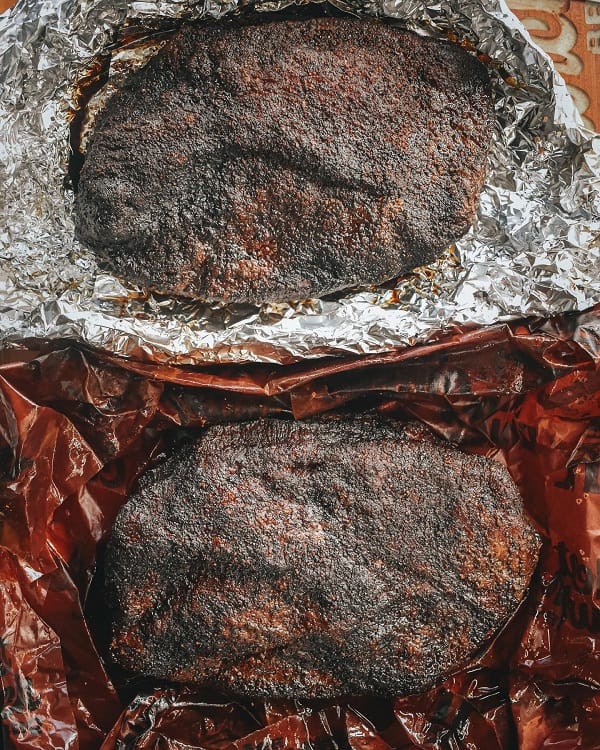
To get the most flavor out of your pork butt, it’s important to use a blend of seasonings that complement the pork flavor. A good blend of seasonings typically includes garlic powder, onion powder, oregano, paprika, cumin, thyme, and chili powder. However, feel free to experiment with different seasoning combinations.
Now that you’ve selected your seasoning blend, it’s time to apply it to your pork butt. Start by rubbing the seasoning blend onto your pork butt, then let it sit for 10-15 minutes. This will allow the seasonings to penetrate the meat and give it a delicious flavor.
You have a few options when you’re ready to cook your pork butt. You can roast your pork butt in the oven, smoke it on the grill, or even slow-cook it in the crockpot. No matter which cooking method you choose, the key is to keep an eye on the temperature and cook it to an internal temperature of 145°F.
Once your pork butt is finished cooking, it’s important to rest for at least 10 minutes before slicing or shredding it. This will help to keep the juices inside the pork butt, making it as juicy and flavorful as possible.
Now that you know the basics of seasoning a pork butt, you’re ready to get cooking! With simple tips and tricks, you can easily season your pork butt like a pro and have a delicious and juicy meal on the table in no time.
FAQs About When To Wrap Pork Butt
What Is The Ideal Internal Temperature For Fully Cooked Pork Butt?
The ideal internal temperature for a fully cooked pork butt is 200°F, but one may remove it from heat when it reaches 195°F and let it rest for 10-15 minutes as its temperature will continue to increase. The best way to determine if pork butt is ready is by using an instant-read thermometer inserted into the thickest part of the meat.
What Is The Purpose Of Bark Formation On Pork Butt?
Bark formation on pork butt is an important aspect in smoking meat. Bark is the crust that is formed on the surface of the meat during the cooking process and it is responsible for the delicious flavor that barbecue is known for. The formation of bark is a result of complex chemical reactions that occur due to the exposure of meat to heat and smoke.
The spice rub used on the meat plays a crucial role in the formation of the bark. Water-soluble and fat-soluble ingredients in the rub dissolve in the moisture of the meat and the smoke, creating a gritty paste on the surface of the meat. As the meat cooks, the paste hardens and forms the outer layer of the bark.
The pork butt’s moisture also evaporates and as a result, the proteins on the meat’s surface bond together and form polymers, which create the inner layer of the bark. As the meat is exposed to smoke, it takes on a dark mahogany color and gains a smoky flavor.
The purpose of bark formation on pork butt is to provide a crunchy, flavorful crust that is desirable to barbecue enthusiasts. The factors affecting bark formation include the rub used, the length of time the meat is exposed to smoke, and moisture levels during cooking.
Why Is Fat Rendering Important When Cooking Pork Butt?
Fat rendering is an important process when cooking pork butt, as it affects the meat’s texture, flavor, and overall outcome. Pork fat begins to render when it hits the 130-140 degree range and needs to be held at this temperature for several hours in order to render properly. When fat is heated too quickly, it will burn instead of melting into the surrounding meat fibers.
This process is slow, taking 3 to 4 hours to complete. The fat lubricates the muscle fibers as they lose moisture from the heat, keeping the meat juicy even as the temperature rises and the fibers begin to shrink and toughen. Fat also absorbs many of the compounds found in the food that the pig eats, making it a source of intense flavor. Rendered fat is also essential to the texture of slow-smoked meats.
Is Probing The Meat Necessary When Cooking Pork Butt?
Probing the meat is a necessary step when cooking a pork butt. This cut of meat is dense with connective tissues, and it requires slow cooking to break down the fibers and produce tender, juicy meat. To ensure the meat is fully cooked, it is important to insert a meat thermometer into the thickest part of the pork butt. To avoid bones and pockets of fat, the thermometer should be probed toward the center of the meat for an accurate reading.
Best Wood For Smoking Pork Butt
When it comes to smoking pork butt, there are a variety of options when it comes to choosing the best wood. Factual data suggests that hickory or applewood is the top choice for creating a unique and savory flavor. Hickory has a medium-high amount of smoke with sweetness, while applewood is considered the best overall for smoking pork.
Other options include the fruitwoods like cherry and peach or heartier woods like pecan. Ultimately, choosing the best wood for smoking pork butt will depend on personal preference and the desired flavor profile.
Can You Wrap A Pork Butt Too Tightly?
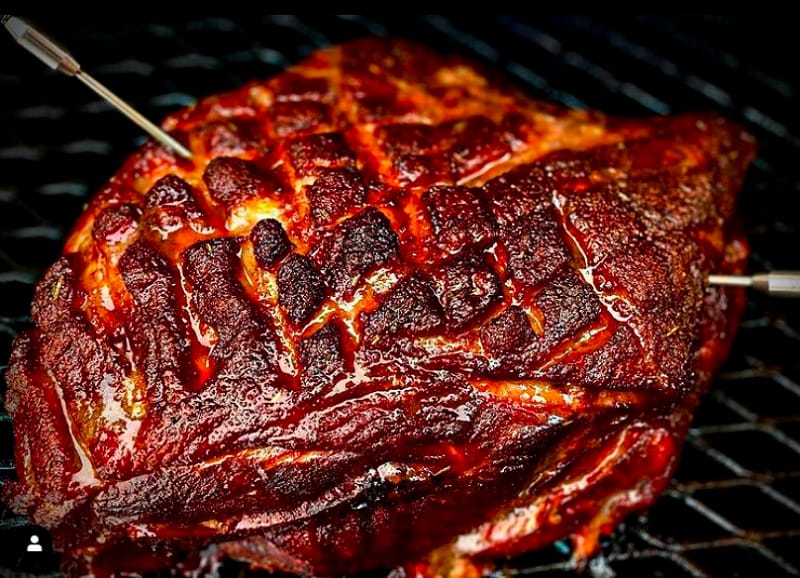
When cooking a pork butt, wrap it at the right temperature to ensure it stays moist and tender. According to factual data, the best time to wrap the pork butt in foil is when it has an internal temperature of 165°F. However, some experts suggest wrapping it earlier, around 150°F.
The ideal time to wrap the pork butt is when the bark is firm and beginning to crack. It’s important not to overcook the meat, as this can make it tough and dry. Ultimately, when to wrap the butt is more of a personal choice than an exact science, but wrapping it at the right time can make a big difference in the final result.
Are Any Negative Effects Of Wrapping A Pork Butt Too Early Or Too Late?
Wrapping pork butt too early can soften its characteristic bark, while wrapping it too late can expose the meat to other negative effects. Wrapping the meat at the right time helps to seal in the juices, reduces the cooking time, and improves the overall tenderness of the meat. Wrapping the butt protects the color of the meat, prevents it from taking on too much smoke flavor, and ultimately speeds up the cooking process. Therefore, paying attention to the meat’s temperature and ensuring it reaches between 150 and 170 degrees before wrapping is crucial. Doing so guarantees that the pork butt is perfectly cooked and ready to enjoy.
Conclusion
Knowing when to wrap pork butt is an important part of the cooking process and can make the difference between a succulent and juicy roast or a dry and tough piece of meat. By taking into consideration all of the factors discussed, you can ensure that you get the most out of your pork butt, no matter what the desired outcome is.
References:
- https://www.masterclass.com/articles/how-to-wrap-a-smoked-pork-butt-with-pitmaster-aaron-franklin
- https://barbecuebible.com/2021/03/19/to-wrap-or-not-to-wrap-barbecued-meats/

Hey readers! Chip Holland here, and I’m a Manager of this website. My passion for writing about it only matches my passion for BBQ. Follow my blog for mouth-watering recipes, tips, and tricks for the perfect smoke, grill, and BBQ. I’m sure you won’t be disappointed!
